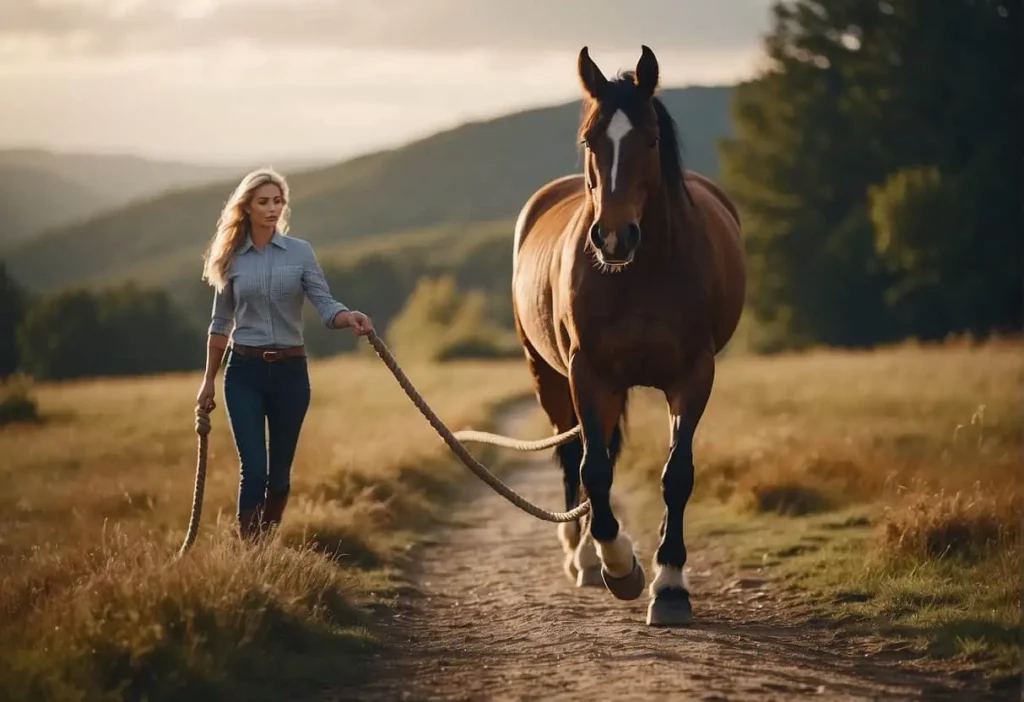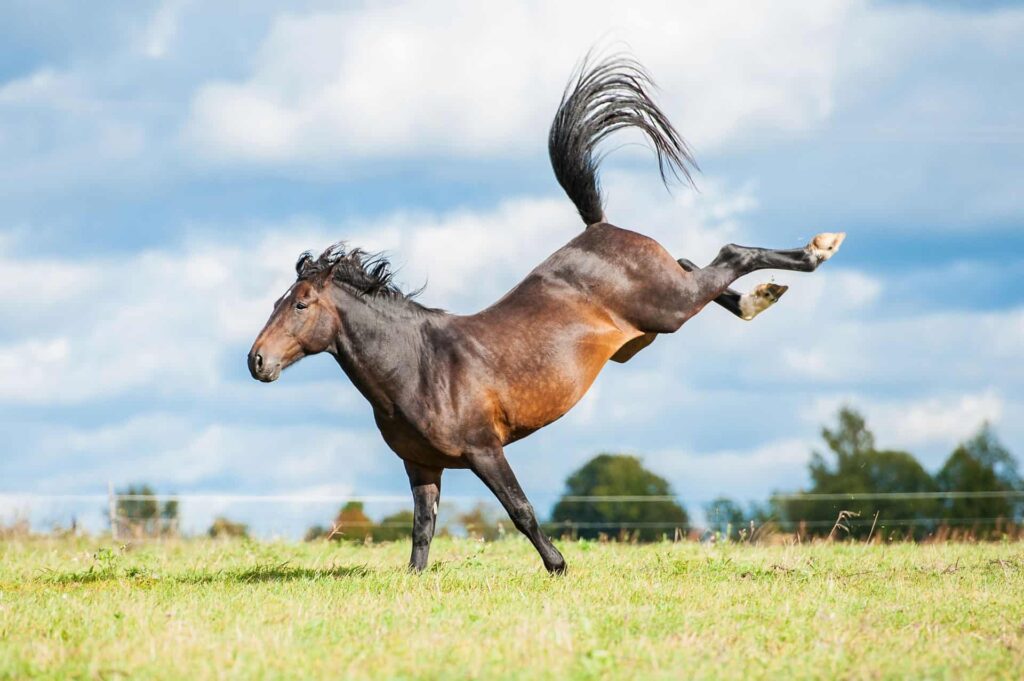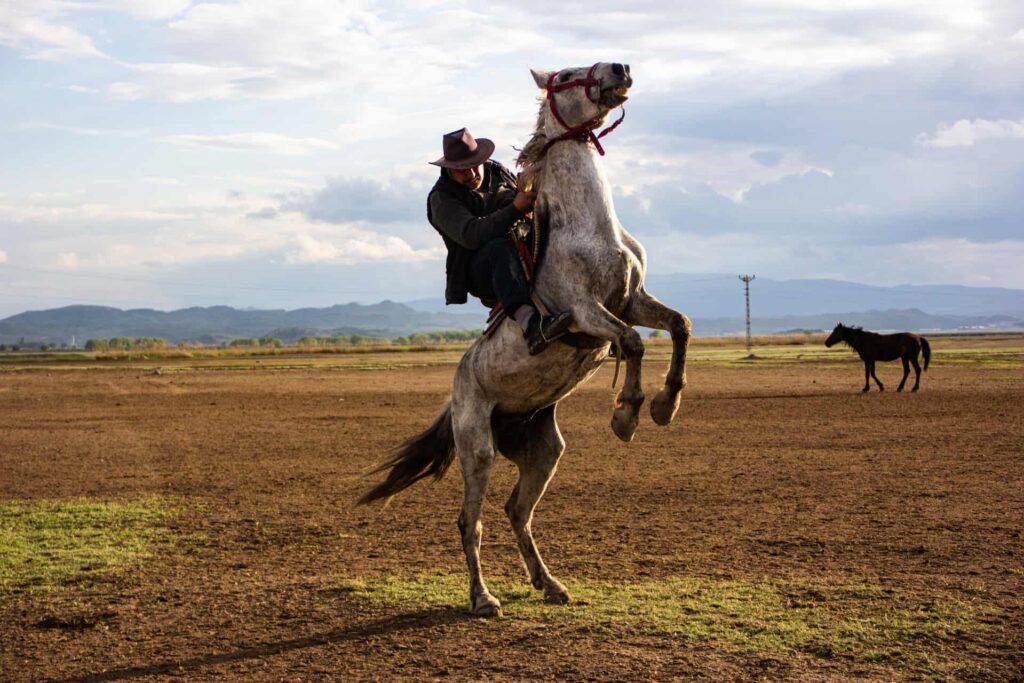Leading a horse is a fundamental skill that horse owners and handlers must acquire to ensure safety and establish clear communication with their equine partners. It involves more than simply holding onto a lead rope; it requires an understanding of horse behavior and body language to foster trust and respect. When leading, it is paramount to approach a horse with confidence and a calm demeanor, as horses are highly sensitive to human emotions and can mirror them.
It’s crucial to prepare both yourself and the horse for the task of leading, and prioritizing safety with the appropriate gear and a secure environment. The basics of leading a horse include knowing where to stand, how to hold the lead rope, and confidently guiding the horse with clear, consistent cues. As both the handler and horse grow more comfortable with each other, advanced leading techniques can be incorporated to navigate various scenarios and challenges that may arise.
Key Takeaways
- Leading a horse combines understanding its behavior with effective communication.
- Safety and preparation are essential before attempting to lead.
- Mastery of basic leading skills paves the way for advanced techniques and a stronger bond.
Understanding Horse Behavior
Effective leadership when leading a horse involves understanding their behavior and knowing how to communicate trust and respect. Recognizing the horse’s body language and signs of discomfort is paramount to both the safety of the horse owner and the animal.
Establishing Trust and Respect
Trust and respect are the foundation of a strong bond between horse and owner. To establish this, a horse owner must consistently practice clear communication, provide a safe environment, and ensure positive interactions. Consistent handling and positive reinforcement encourage a horse to see the owner as a leader. Trust is built over time with patience and by demonstrating leadership. A horse that trusts its owner is likely to follow cues without resistance.
- Key behaviors to foster trust:
- Consistent routines and responses
- Patience during training and handling
- Positive reinforcement for desired behavior
Recognizing Signs of Discomfort
Safety should always be a priority, and part of maintaining a safe environment is recognizing when a horse is experiencing tension or discomfort. Horses communicate distress through various behavioral changes, and it’s important for owners to be able to identify these signs to avoid potential injury. Tension in the horse can be signaled by ears pinned back, stomping, or tail swishing. Discomfort might present itself as resistance to being led or touched. A horse displaying signs of distress should be approached cautiously and may require examination by a veterinarian to rule out injury or illness.
- Indicators of discomfort or tension:
- Ears pinned back against the head
- Stomping or shifting weight between hooves
- Tail swishing, eye-rolling, or head tossing
Safety and Preparation
When leading a horse, safety is paramount, and it begins with selecting the appropriate equipment. Ensuring that both the handler and the horse are equipped correctly minimizes risk and enhances control during leading.
Choosing the Right Equipment
The foundation of safe horse-leading equipment begins with a well-fitted halter. Whether you choose a standard halter or a rope halter, it should fit the horse securely without causing discomfort. The halter should allow for easy attachment of a lead rope while ensuring that the horse cannot easily slip out of it.
For the lead rope, choose one that is sturdy and offers a good grip. It should be long enough to allow for flexibility but not so long that it drags on the ground or creates a tripping hazard. A rope approximately 6-8 feet in length is typically suitable for most situations.
While not always necessary, a dressage whip can be used as an extension of the handler’s arm to guide and direct the horse from a safe distance. It should never be used to harm the horse but can be handy to reinforce commands and signals gently.
When handling the equipment, one should check for any wear or damage before each use to ensure it remains reliable. Remember not to overlook the importance of maintenance. Regular inspection of the halter and lead rope can prevent accidents due to equipment failure.
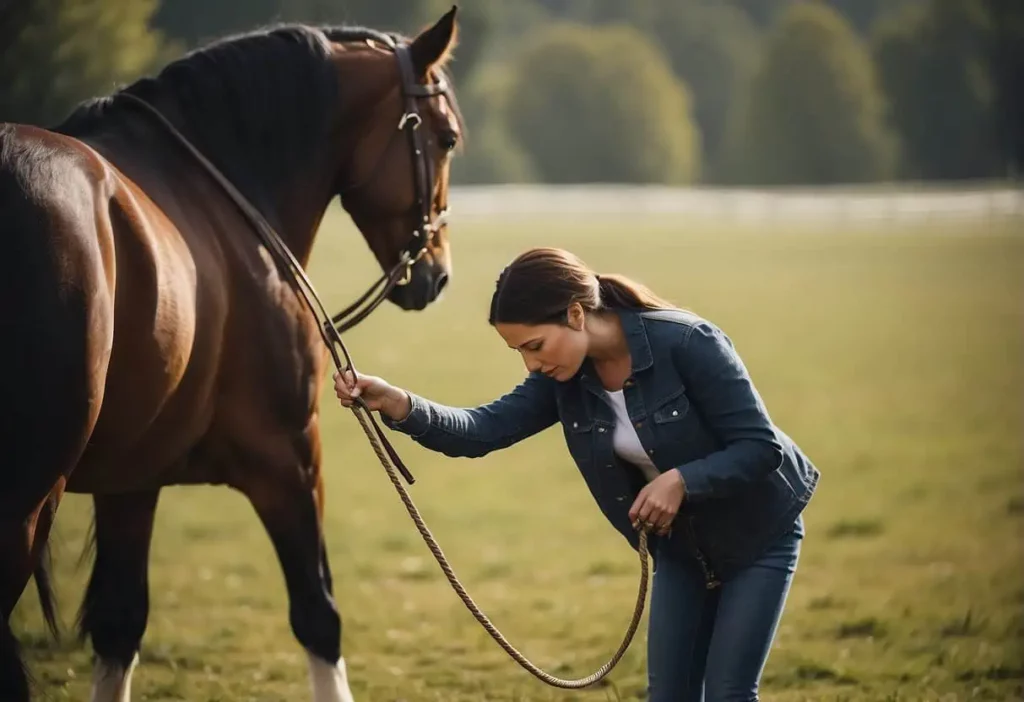
The Basics of Leading
Proper techniques in leading a horse involve a safe and respectful approach, correct handling of the lead rope, and body language that communicates clear intentions. This ensures the safety and cooperation of both the handler and the horse.
Approaching and Haltering
When approaching a horse, it’s important to do so at an angle that is visible to the horse to avoid startling it. Always approach with confidence and a calm demeanor to foster trust. Once near, one should speak softly to the horse and extend a hand gently towards its cheek or neck. The halter should be placed quietly and securely, ensuring the fit is comfortable but firm to maintain control.
Holding the Lead Rope
The correct way to hold a lead rope involves using a grip that is firm yet flexible. One should hold the rope in the hand closest to the horse, about 6-8 inches from the halter with the remainder of the rope folded neatly in the other hand to avoid slack that could get tangled. Never wrap the rope around the hand, as this can lead to injuries if the horse pulls away.
Positioning and Body Language
Positioning oneself is vital for safe and effective leading. The handler should stand next to the horse’s shoulder, maintaining a balanced stance that enables them to walk at the horse’s pace and keep control without invading the horse’s personal space. Using deliberate and purposeful body movements can reinforce the handler’s directions, ensuring the horse understands their expectations.
Advanced Leading Techniques
Advanced leading techniques are essential for fostering better communication and control when handling a horse. These methods go beyond the basics, focusing on nuance and the subtle interplay between handler and animal.
Teaching Commands and Cues
A horse’s ability to respond to commands reliably is paramount. Introducing verbal cues such as “walk forward” or “turn left” should be done with consistency and paired with respective physical cues for reinforcement. For instance, the inside leg pressure can be used to cue a horse to move away or clucking to encourage forward motion. One must use body position strategically to guide the horse’s direction, ensuring the cues are distinct and not confusing to the horse.
Changing Directions and Paces
Adjusting a horse’s direction and pace demands a higher level of skill. To turn left, the handler must give a clear verbal cue alongside a gentle but firm tap on the right side. The handler’s position should also shift slightly to the left to cue the horse accordingly. To change pace, the handler must modulate their own pace and use verbal signals like “trot” or “canter,” while reinforcing the command with consistent body language.
Navigating Different Environments
Leading a horse through various environments includes challenges such as dealing with a crowd, traversing a paddock, or managing bad ground manners. Handlers must remain vigilant and adaptive, using their commands and cues to keep the horse focused on the destination. In crowded areas, maintaining a firm but calm command presence prevents the horse from feeling anxious. When navigating difficult terrain, alternating the pace and using specific cues can help maintain the horse’s balance and confidence.
Communication and Positive Reinforcement
Effective communication and positive reinforcement are foundational in leading a horse with confidence and clarity. Employing verbal cues and rewarding good behavior fosters a bond based on trust and understanding between the horse and the handler.
Understanding and Using Verbal Cues
One should use verbal cues consistently when leading a horse. Common cues include words such as “walk,” “stand,” or “back,” as well as sounds like clucking to encourage forward movement. The horse learns to associate these verbal cues with the desired action through repetition and patience. The handler needs to remain calm and composed, using a clear and steady voice to convey instructions.
Rewarding Good Behavior
When a horse responds correctly to a verbal cue, immediate positive reinforcement is crucial. This can take the form of vocal praise, such as a cheerful “good boy” or “good girl,” or physical treats. The use of positive reinforcement encourages the horse to repeat the behavior and strengthens the communication bond over time. Patience plays a key role here, as it may take multiple attempts for a horse to understand and respond to cues promptly.
Note: Positive reinforcement must be timely to be effective; this means rewarding the horse immediately after the desired behavior to reinforce the connection.
Handling Specific Behaviors
When leading a horse, it’s essential to understand how to correct behaviors such as reluctance or laziness and address resistance such as balking. The key to managing these behaviors lies in the use of clear, consistent cues and appropriate reinforcement.
Correcting Reluctance or Laziness
Horses exhibiting reluctance or laziness can often be encouraged to move forward with the combination of a firm and gentle approach. To initiate movement, they should first be given a verbal cue such as “walk on.” If this is ineffective, a gentle tap with a dressage whip can reinforce the command, ensuring not to startle or harm, but to simply motivate. It’s important to immediately reward the horse with a pat or verbal praise as soon as it responds correctly to encourage the desired behavior.
- Verbal cue: “Walk on”
- Reinforcement: Gentle tap with a dressage whip
- Reward: Pat or verbal praise upon correct response
Addressing Resistance or Balking
When a horse balks or shows resistance, the handler must remain calm and confident. One should first ask the horse to stop and back up, reaffirming the handler’s position as the leader. Consistency is crucial. The horse should be asked to yield to pressure firmly yet gently. It is often helpful to break down the task into smaller, manageable steps, rewarding each step to build their confidence and compliance.
- Command: Stop and back up
- Technique: Firm yet gentle pressure to yield
- Compliance: Reward each small step
In both scenarios, the handler’s demeanor plays a crucial role in achieving a positive outcome, using a balanced approach that respects the horse’s needs while also asserting leadership.
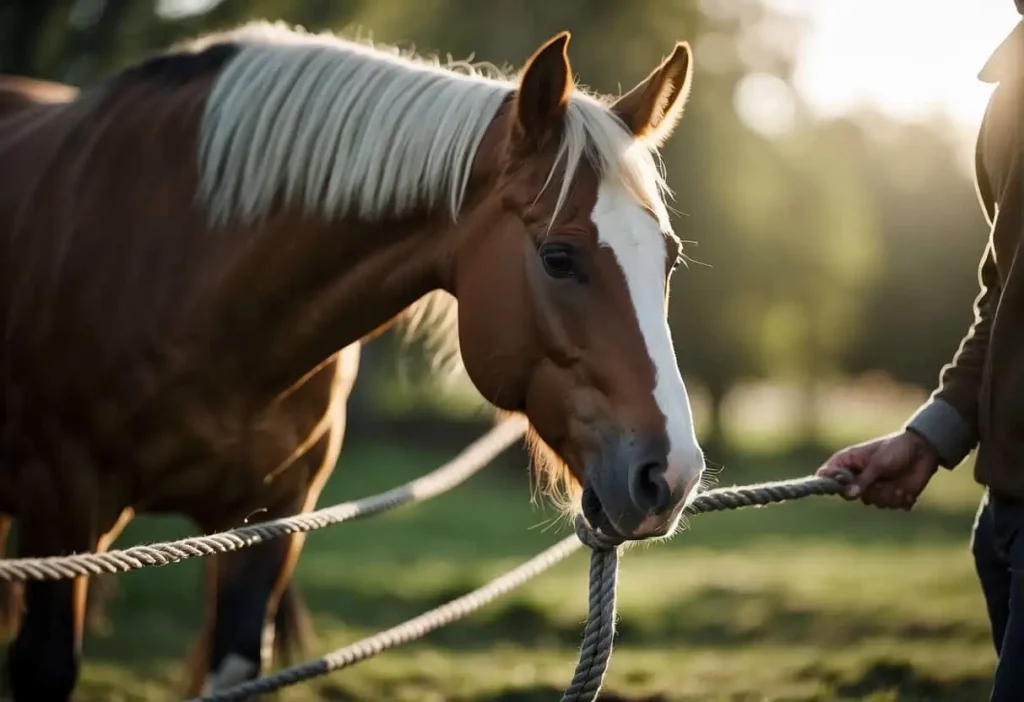
Building a Stronger Equestrian Bond
Building a bond between horse and rider is pivotal for equestrian success. This relationship is rooted in trust, confidence, and consistency, enhancing both safety and performance.
Maintaining Consistency in Training
Consistent training schedules and methods are fundamental in establishing a strong equestrian bond. Riders should establish a routine that their horses can anticipate and feel secure with. Consistent cues and clear commands contribute to building confidence in both the horse and the rider.
- Daily Routines: Engage in training at the same time each day to foster a sense of stability.
- Training Techniques: Use the same techniques to avoid confusing the horse and to reinforce learning.
Creating a Fun and Engaging Experience
Incorporating fun into training ensures a positive association with learning and strengthens the bond. Riders can introduce games or varied exercises to make training enjoyable while still focusing on skill development.
- Varied Exercises: Mix in different patterns and terrains to keep the horse mentally stimulated and engaged.
- Relaxation Time: Allot time for gentle grooming or grazing post-training, which can enhance trust and provide a pleasurable experience for the horse.
Conclusion
When leading a horse, the equestrian must possess a clear understanding of the animal’s behavior and trust-building techniques. They should approach the horse calmly, with a focus on positive reinforcement. Experiencing a reliable and patient connection with the horse is paramount, which is foundational to the horse’s willingness to follow the lead.
The rider’s body language is a critical communication tool when leading a horse. They must exhibit confidence and maintain a consistent demeanor to reinforce the horse’s comfort and compliance. Proper use of a halter and lead rope can enhance communication between the equestrian and the horse. Correct positioning—beside the horse’s shoulder—allows for effective direction while also upholding a safety margin.
Equestrian safety should never be compromised; wearing appropriate gear and being aware of the surroundings are essential precautions. Ongoing education and hands-on experience contribute significantly to a rider’s ability to lead effectively. Learning from professionals, attending workshops, or engaging with online resources, like the study on Leadership skills developed through horse experiences, can enrich a rider’s understanding and capability.
In essence, the art of leading a horse intertwines the firm application of learned skills with the sensitivity to individual horse behaviors. This balance fosters trust and establishes a dynamic where the horse is willing to be led, embodying the proverb, “You can lead a horse to water…” As research suggests, the connection established through consistent and educated leading methods not only develops horsemanship but can yield valuable insights applicable to other areas of life.
Responsibilities and Etiquette
Leading a horse requires a blend of assertiveness, respect, and awareness. The leader must maintain safety and control while honoring the horse’s personal space and pace.
Understanding Your Role as a Leader
When leading a horse, the individual’s primary role is to guide with confidence and clarity. Safety is paramount; they must consistently ensure the environment is secure for both the horse and any bystanders. Control does not mean force—it involves a firm yet placid presence, signaling to the horse that they are a reliable leader. Positioning is crucial; one should stand at the horse’s shoulder, holding the lead rope firmly but without unnecessary tension.
Respecting the Horse’s Space and Pace
Acknowledging personal space is vital in equine etiquette. A horse’s personal bubble should be respected to avoid discomfort or anxiety, which means the leader should not crowd the animal. Similarly, the horse’s pace should mirror its natural rhythm. Abrupt changes can unsettle the horse, so transitions in speed should be smooth and deliberate. A responsible leader is vigilant and abides by these principles, ensuring harmony and trust between rider and horse.
Frequently Asked Questions
Leading a horse requires a clear understanding of the proper techniques to ensure safety and cooperation. Here are some answers to the most common queries for handlers of all levels.
What is the proper way to lead a horse by hand for beginners?
For beginners, leading a horse by hand involves approaching the horse calmly, standing on its left, and holding the lead rope near the halter with one hand while the other holds the end of the rope. Your grip should be firm but gentle, and your body language should convey confidence.
What techniques can be used to lead an unwilling horse?
To lead an unwilling horse, try to motivate and encourage movement without force. Use a calm voice and gentle pressure on the lead rope. It’s essential to be patient and consistent, rewarding every positive step to reinforce good behavior.
Why is it traditionally recommended to lead a horse from the left side?
Traditionally, leading a horse from the left side is a practice rooted in history when soldiers needed to keep their right hand free for their weapon. It has since become a standard because it offers convenience for mounting and consistency for the horse.
What are the important safety precautions to take when leading a horse?
Important safety precautions include always wearing suitable footwear, keeping a safe distance to avoid being stepped on, and never wrapping the rope around your hand or body. Stay alert and attentive to the horse’s movements and your surroundings.
How can you teach a horse to follow your lead effectively?
Teaching a horse to follow your lead involves establishing trust and respect through consistent training. Start with leading in short sessions, using clear, calm commands, and rewarding good behavior. Practice in a safe, enclosed area until the horse is comfortable and responsive.
In what ways can you prevent a horse from pulling while being led?
To prevent a horse from pulling, maintain a steady pace and direction while leading. Employ a halter that offers enough control to correct pulling without causing discomfort, and utilize training sessions focused on desensitizing the horse to the stimuli that trigger pulling.
Last Updated on January 30, 2024 by Nate Dewsbury
